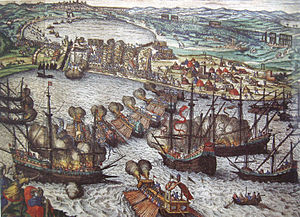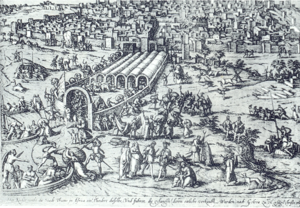- Conquest of Tunis (1535)
-
Conquest of Tunis Part of the Ottoman-Habsburg wars
and the Portuguese-Turkish Wars
Attack on La Goletta, with Tunis in the background.

Entry of Charles I of Spain into Tunis in 1535.Date June, 1535 Location Tunis (present-day Tunisia) Result Decisive allied victory[1]
Tunis under Spanish rule[2]Belligerents  Empire of Charles V:
Empire of Charles V:
 Republic of Genoa
Republic of Genoa
 Kingdom of Portugal
Kingdom of Portugal
 Papal States
Papal States
 Knights of Malta
Knights of Malta Ottoman Empire
Ottoman Empire
 France
FranceCommanders and leaders  Charles I-V
Charles I-V
 Álvaro de Bazán
Álvaro de Bazán
 Luis de Requesens
Luis de Requesens
 García de Toledo
García de Toledo
 Duke of Alba
Duke of Alba
 Andrea Doria
Andrea Doria
 Duke of Beja
Duke of Beja
 Virginio Ursino
Virginio Ursino Hayreddin Barbarossa
Hayreddin BarbarossaStrength Total men: 60,000
Total ships: 398
 207 Spanish ships[3]
207 Spanish ships[3]
Other Spanish territories: 60 Flemish hulks
60 Flemish hulks 10 Sicilian galleys
10 Sicilian galleys 6 Neapolitan galleys
6 Neapolitan galleys
 19 galleys
19 galleys
 1 man-of-war and 20 caravels
1 man-of-war and 20 caravels
 8 galleys
8 galleys
 4 galleys
4 galleys 82 warships[4]
82 warships[4]
 2 galleys[5]
2 galleys[5]Casualties and losses Unknown: Many fell to dysentery At least 30,000 civilians casualties
82 ships destroyedBalearics (1501) – Algiers (1516) – Tlemcen – Mohács (1526) – Hungary (1527–1528) – Algiers (1529) – Formentera – Balkans – Vienna (1529) – Little War (1530–1552) – Coron – Tunis (1534) – Tunis (1535) – Mahon – Osijek – Preveza – Castelnuovo – Alborán – Algiers (1541) – Nice – Mahdiye – Gozo – Tripoli – Eger – Ponza – Corsica – Oran (1556) – Bougie – Balearics (1558) – Mostaganem – Djerba – Orán and Mers-el-Kebir – Malta – Aceh – Szigetvár – Lepanto – Tunis (1574) – Fez – Long War – Cape Corvo – Cape Celidonia – 1663-1664 – Great Turkish War – 1716-1718 – 1737–1739 – 1787–1791Turkish Crusade (1481) · Battle of Diu (1509) · Conquest of Goa (1510) · Conquest of Tunis (1535) · Ottoman–Portuguese Conflicts (1538–1557) · Ottoman–Portuguese Conflicts (1558–1563) · Battle of Ksar El Kebir · Ottoman–Portuguese Conflicts (1580–1589) · Ottoman–Venetian War (1714–1718)
The Conquest of Tunis in 1535 was an attack on Tunis, then under the control of the Ottoman Empire, by the Spanish Empire.
Contents
Background
In 1533, Suleiman ordered Hayreddin Barbarossa, whom he had summoned from Algiers, to build a large war fleet in the arsenal of Constantinople.[6] Altogether 70 galleys were built during the winter of 1533–1534, manned by slave oarsmen, including 1,200 Christian ones.[7] With this fleet, Barbarossa conducted aggressive raids along the coast of Italy, until he conquered Tunis on 16 August 1534, ousting the local ruler, theretofore subservient to the Spanish, Muley Hasan.[8] Barbarossa thus established a strong naval base in Tunis, which could be used for raids in the region, and on nearby Malta.[9]
Charles V, one of the most powerful men in Europe at the time, assembled a huge army of some 30,000 soldiers, 74 galleys (rowed by chained Protestants shipped in from Antwerp),[10] 300 sailing ships, the Santa Anna, the largest ship in the world at the time,[11] and Portuguese galleon São João Baptista, also known as Botafogo, with 366 bronze cannons to drive the Ottomans from the region.[12] The expense involved for Charles V was considerable, and at 1,000,000 ducats was on par with the cost of Charles' campaign against Suleiman on the Danube.[13] Unexpectedly, the funding of the conquest of Tunis came from the galleons sailing in from the New World, in the form of a 2 million gold ducats treasure extracted by Francisco Pizarro in exchange for his releasing of the Inca king Atahualpa (whom he nevertheless executed on 29 August 1533).[14]
Despite a request by Charles V, Francis I denied French support to the expedition, explaining that he was under a 3 year truce with Barbarossa following the 1533 Ottoman embassy to France.[15] Francis I was also under negotiations with Suleiman the Magnificent for a combined attack on Charles V, following the 1534 Ottoman embassy to France. Francis I only agreed to the Pope Paul III's request that no fight between Christians occur during the time of the expedition.[16]
The Battle
On 1 June 1535, protected by a Genoese fleet, Charles V destroyed Barbarossa's fleet and, after a costly yet successful siege at La Goletta, captured Tunis. In the ruins, the Spanish found cannon balls with the French Fleur-de-lys mark, evidence of the contacts stemming from the Franco-Ottoman alliance.[17]
The resulting massacre of the city left an estimated 30,000 dead. Barbarossa managed to flee to Algiers with a troop of several thousands Turks.[18] Muley Hasan was restored to his throne.[19] The stench of the corpses was such that Charles V soon left Tunis and moved his camp to Radès.
The siege demonstrated the power projection of the Habsburg dynasties at the time; Charles V had under his control much of southern Italy, Sicily, Spain, the Americas, Austria, Netherlands and lands in Germany. Furthermore, he was Holy Roman Emperor and had de jure control over much of Germany as well.
The catastrophic defeat in the Capture of Tunis in 1535 by the Holy League motivated the Ottoman Empire to enter into a formal alliance with France against the Habsburg Empire. Ambassador Jean de La Forêt was sent to Constantinople, and for the first time was able to become permanent ambassador at the Ottoman court and to negotiate treaties.[20]
Aftermath
Main article: Conquest of Tunis (1574)Barbarossa managed to escaped to the harbour of Bone, where a fleet was waiting for him. From there, he sailed to accomplish the Sack of Mahon, where he took 6,000 slaves and brought them to Algiers.[21]
The Ottomans responded by recapturing the city in 1574. However the Ottoman governors of Tunis were semi-autonomous Beyliks who acted as privateers against Christian shipping. Consequently, raiding in the Mediterranean continued until the French subjugated the region as a protectorate three centuries later in 1830 with an invasion leading to the creation of French Algeria, and the establishment of a Protectorate over Tunisia in 1881 through the French occupation of Tunisia.
Gallery
-
Charles V going to Radès.
-
Charles V announcing the capture of Tunis to Pope Paul III in 1535.
-
Imperial troops in the conquest of Tunis, 1535, Jan Cornelisz Vermeyen.
See also
- Barbary Pirates
- Battle of La Goleta
- Journey of Algiers
- Siege of Castelnuovo
- Battle of Djerba
- Siege of Malta
- Battle of Lepanto
- Ottoman-Habsburg wars
- Portuguese-Ottoman Wars
Notes
- ^ History of the Ottoman Empire and modern Turkey Ezel Kural Shaw [1]
- ^ History of the Ottoman Empire and modern Turkey Ezel Kural Shaw [2]
- ^ 15 galleys of the Mediterranean Squadron, 42 ships of the Cantabrian fleet, 150 ships of the Málaga Squadron
- ^ Crowley, p.61
- ^ Garnier, p.96
- ^ Crowley, p.56
- ^ Crowley, p.57
- ^ Crowley, p.58
- ^ Crowley, p.58
- ^ Crowley, p.59
- ^ Crowley, p.59
- ^ Crowley, p.60
- ^ Crowley, p.62
- ^ Crowley, p.62
- ^ Garnier, p. 94–95
- ^ Garnier, p. 94–95
- ^ Crowley, p.60
- ^ Crowley, p.61
- ^ Crowley, p.61
- ^ History of the Ottoman Empire and modern Turkey Ezel Kural Shaw p.97 [3]
- ^ E.J. Brill's first encyclopaedia of Islam 1913-1936 by M. Th. Houtsma p.872
References
- Battle: a Visual Journey Through 5000 Years of Combat. Grant, R. G. 2005
- La Marina Cántabra. Ballesteros-Beretta, Antonio. 1968
- Cervantes Virtual
- Roger Crowley, Empire of the sea, 2008 Faber & Faber ISBN 978-0-571-23231-4
- Garnier, Edith L'Alliance Impie Editions du Felin, 2008, Paris ISBN 978-2-86645-678-8 Interview
Categories:- Conflicts in 1535
- Wars involving the Ottoman Empire
- Wars involving the Holy Roman Empire
- Battles involving Portugal
- 16th century in Africa
- Military history of Tunisia
- Tunis
Wikimedia Foundation. 2010.








